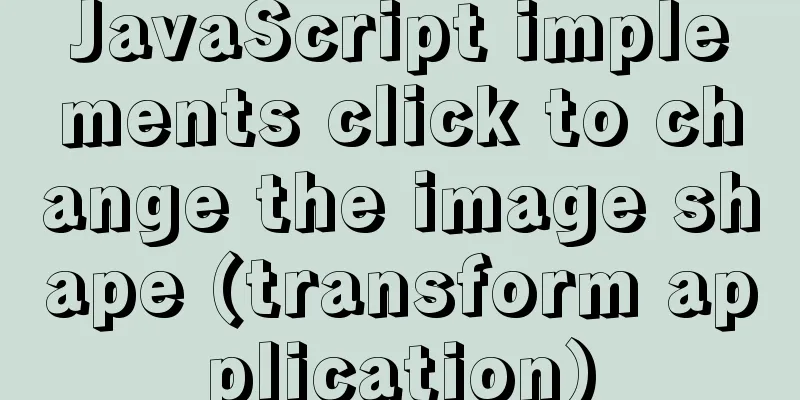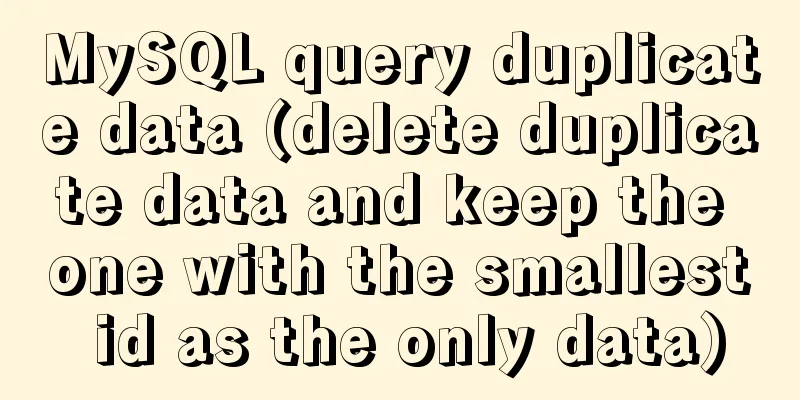JavaScript implements click to change the image shape (transform application)

|
JavaScript clicks to change the shape of the picture (application of transform), for your reference, the specific content is as follows Attach the code:
<!DOCTYPE html>
<html lang="en">
<head>
<meta charset="UTF-8">
<title>Application of transform</title>
<style type="text/css">
#box{
width: 50px;
height: 50px;
background-color: red;
/*traslate displacement rotate rotation amplitude scale magnification skew tilt*/
/*transform: translate(100px,200px) rotate(20deg) scale(2.0) skew(10deg);*/
}
</style>
</head>
<body>
<button id="btn">Deform</button>
<div id="box"></div>
<script>
window.onload = function (){
var btn = document.getElementById("btn");
var box = document.getElementById("box");
var index = 0;
btn.onclick = function (){
index++;
box.style.transform = `translate(${index*100}px,${index*50}px) rotate(${index*10}deg) scale(${index*1.3})`;
}
}
</script>
</body>
</html>Implementation effect diagram:By default:
After clicking Transform:
Click again to continue changing. The following is an extension of the application of transform to the movement of the clock:
<!DOCTYPE html>
<html lang="en">
<head>
<meta charset="UTF-8">
<title>Digital Clock Case</title>
<style type="text/css">
*{
padding: 0;
margin: 0;
}
#clock{
width: 600px;
height: 600px;
background: url("img/clock.jpg") no-repeat;
position: relative;
}
#hour,#minute,#second
position: absolute;
width: 30px;
height: 600px;
left: 50%;
margin-left: -15px;
}
#hour{
background: url("img/hour.png") no-repeat;
}
#minute{
background: url("img/minute.png") no-repeat;
}
#second{
background: url("img/second.png") no-repeat;
}
</style>
</head>
<body>
<div id="clock">
<div id="hour"></div>
<div id="minute"></div>
<div id="second"></div>
</div>
<script type="text/javascript">
// 1. Get the tag var hour = document.getElementById("hour");
var minute = document.getElementById("minute");
var second = document.getElementById("second");
// 2. Start the timer to get the current time setInterval(function (){
// 2.1 Get the current timestamp var now = new Date();
// 2.2 Get hours, minutes, seconds var s = now.getSeconds();
var m = now.getMinutes() + s/60;
var h = now.getHours()%12 + m/60;
// 2.3 Rotation second.style.transform = `rotate(${s*6}deg)`;
minute.style.transform = `rotate(${m*6}deg)`;
hour.style.transform = `rotate(${h*30}deg)`;
},10)
</script>
</body>
</html>Attached is the effect picture (it is now 8:01):
The above is the full content of this article. I hope it will be helpful for everyone’s study. I also hope that everyone will support 123WORDPRESS.COM. You may also be interested in:
|
<<: Detailed tutorial on installing Docker on CentOS 7.5
>>: Master-slave synchronization configuration and read-write separation of MySQL database
Recommend
Vue project realizes paging effect
The paging effect is implemented in the vue proje...
Detailed explanation of the difference between v-model directive and .sync modifier in Vue
Table of contents v-model .sync The difference in...
Summary of some common configurations and techniques of Nginx
Preface This article lists several common, practi...
Linux uses suid vim.basic file to achieve privilege escalation
Reproduce on Kali First set suid permissions for ...
Vue2/vue3 routing permission management method example
1. There are generally two methods for Vue routin...
Tutorial on installing Tomcat server under Windows
1 Download and prepare First, we need to download...
React-Native environment setup and basic introduction
Environment Preparation 1. Environment Constructi...
Website User Experience Design (UE)
I just saw a post titled "Flow Theory and Des...
Nginx one domain name to access multiple projects method example
Background Recently, I encountered such a problem...
Research on the problem of flip navigation with tilted mouse
In this article, we will analyze the production of...
Pure CSS3 realizes the effect of div entering and exiting in order
This article mainly introduces the effect of div ...
Detailed explanation of client configuration for vue3+electron12+dll development
Table of contents Modify the repository source st...
Detailed explanation of destructuring assignment syntax in Javascript
Preface The "destructuring assignment syntax...
Sample code for making desktop applications with vue + Electron
1.vue packaging Here we use the vue native packag...
Pure CSS to achieve hover image pop-out pop-up effect example code
Implementation principle The main graphics are co...












